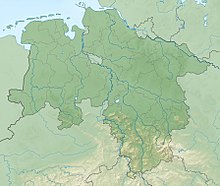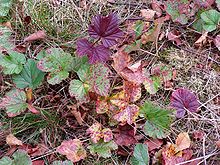Plackenmoor
Coordinates: 53 ° 25 ′ 4 " N , 8 ° 35 ′ 14" E
The nature reserve Plackenmoor is a moor owned by the district of Cuxhaven . It is bordered on two sides, by the Stoteler Moor and Königsmoor. The western border is formed by the federal highway 27 .
The Plackenmoor, Königsmoor and Stoteler Moor nature reserves merge into one another and are managed by the nature conservation authority (s) as the Hahnenknooper Moore nature reserve . They were designated as FFH areas ( Fauna-Flora-Habitat ).
General
The Plackenmoor has a size of 74 hectares and was designated as a nature reserve in 1973 . It consists of broken birch forest and grassland that is no longer passable. This moor can only be walked over the dams.
Waterlogging
From 1999 the damming of the moor areas began, which caused them to become wet due to the accumulation of surface water . The wetland has developed the furthest in these areas . Peat moss ( Sphagnum nemoreum ), sundew ( Drosera rotundifolia ) and swamp calla ( Calla palustris ) form in the swampy grassland areas . These pull down the stubborn rushes and develop the biotope that makes the bog grow, if the biotope is right, the bog grows 1 mm per year.
Special plants
The cloudberry (Rubus chamaemorus), which grows here on an area of 9,000 m², is a special treasure in this wetland . In 2001 a biologist carried out a monitoring with the result that there were 300,000 sprouts.
There are only two cloudberry occurrences in Germany. The second, but small, occurrence is in the Ipweger Moor in the Ammerland district . The cloudberry thrives in the partial shade of the light bog birch . Removing these birch trees would inevitably mean that the entire area would be overgrown by marshmallow (molinia) and thus displaced. Some cloudberry locations have already been destroyed by the spread of pipe grass. In addition, the long dry periods in recent summers have been a problem for the bog.
The crowberry (Empetrum nigrum) the common cranberry (Oxycoccus palustris) and the bilberry (Vaccinium myrtillus) thrive in the areas shaded by birch trees .
Management
In the Plackenmoor there are no longer any grassland areas that can be walked on or cultivated. The waterlogging has gone far.
Wildlife
The bird world is listed under the Hahnenknooper Moore nature reserve . For the crane , the slag bog is a feeding area. For the wild boar it is cost area and habitat.
Precautions
It is forbidden to enter the nature reserves outside of the paths. In the swampy wetlands there is a high risk of death. If you slide into the mud, you hardly have the opportunity to free yourself again.


